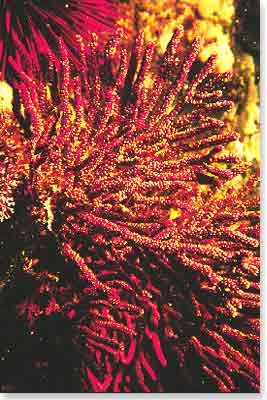Looking like their Caribbean cousins, the Sea Fans, these animals will be most prominent in areas of high planktonic-filled currents. If you look close, the Gorgonian is covered with thousands of small anemone-like polyps. You can age a Gorgonian colony by counting the growth rings formed in the skeletons. These internal skeletons are made up of a substance called gorgonin, hence their name. Different species can be found at different depths and conditions. Colors also vary with species. Gorgonians show up in red, yellow, orange, brown and purple. Gorgonians will inevitably be oriented at right angles to the currents making plankton feeding much more productive for them.
Gorgonian




